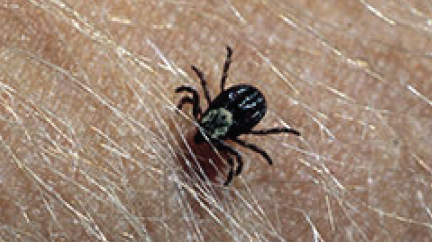by Susan Michaud
Fever, chills, muscle and joint pain, headache, fatigue. No, this is not a list of COVID symptoms, but symptoms of a danger that we Coloradoans need to be aware of every year-tick bites.
Spring is upon us, and so is tick season. According to petbasics. com, ticks thrive in damp, humid conditions, so the recent spring snows will encourage their population to grow.
Quick Facts about ticks in Colorado, compiled by the CSU Extension:
The most common tick that bites humans and dogs in Colorado is the Rocky Mountain wood tick.
Rocky Mountain wood tick is most active and does most biting in spring, becoming dormant with warm weather in summer.
Colorado tick fever is by far the most common tick-transmitted disease of the region. Despite its name, Rocky Mountain spotted fever is quite rare here.
Several repellents are recommended for ticks including DEET, picaridin, IR3535, and oil of lemon eucalyptus.
To remove a tick, grasp it with tweezers, as close to the skin as possible and pull it straight out.
Presently 27 species of ticks are known to occur in Colorado…
Almost all human encounters with ticks in Colorado involve the Rocky Mountain wood tick. Fortunately, some of the most important tick species present elsewhere in the United States are either rare (lone star tick) or completely absent from the state (black-legged tick).
Colorado tick fever
Colorado Tick Fever is the most common disease spread by ticks in Colorado, specifically by the Rocky Mountain wood tick. Caused by a virus, it produces symptoms similar to flu in most people. In about half the cases, a biphasic fever will occur. This is noted by a few days of symptoms, followed by recovery and then a second round of symptoms.
Although symptoms disappear and recovery is complete within a few days or weeks for most people, in rare cases, serious complications can occur when the virus affects the central nervous system. Fever and symptoms usually develop between three and seven days after the tick bite.
Tick paralysis
Although rare, if certain ticks (the Rocky Mountain wood tick in Colorado) remain attached for a long period, it can produce an ascending paralysis. One early symptom mayappear as difficulty with walking. This can progress to more generalized symptoms, such as limb numbness and, if left untreated, difficulty breathing. This condition is completely reversible when the tick is removed.
Tick paralysis can also affect cattle, dogs, and some other mammals. Several years ago, a case of ascending paralysis was reported in a dog in Grand County. Checking for ticks on yourself and your pets will prevent this from happening.
How to prevent tick bites
In addition to the repellents recommended by the Extension, Old Park resident Eldon Holland recommends powdered sulfur. In an article on the ES Independent website (http://eureka.news/natural-remedies-can-repel-ticks), Pat Costner recommends putting a few tablespoons of sulfur powder in the toe of an old sock, tying a knot in the top of the sock, and using it to dust your shoes, socks, and lower legs or pants legs.
Bill Cotton, also an Old Park community member, suggests using permethrin on clothing; however, “If you have cats, you have to be careful since permethrin can be fatal. I like to spray my most likely (to be infested) clothing with permethrin. Supposedly it’s okay once dry, but if you have a cat, you may want to get advice from a vet.” He also notes that “Frontline is not recommended in cat households. Vets recommend alternatives for dogs, like Bravecto(fluralaner) for households with cats and dogs.”
To rid your yard of ticks and fleas, you can use First Saturday Lime. According to their website, “Using a yard spreader, cast 1lb per 20 sq ft across a lawn for prevention of fleas and ticks. Apply monthly starting in the spring to disrupt growth cycle of the pests.”
With awareness and some diligence, tick season does not have to result in time down due to tick-related illnesses. Use repellents that are safe for your family and pets, and be sure to check each other and pets after time spent in the woods, brush and high grasses, as ticks wait to attach themselves to a host in those environments.








